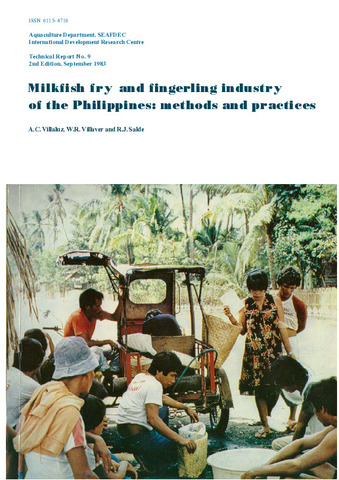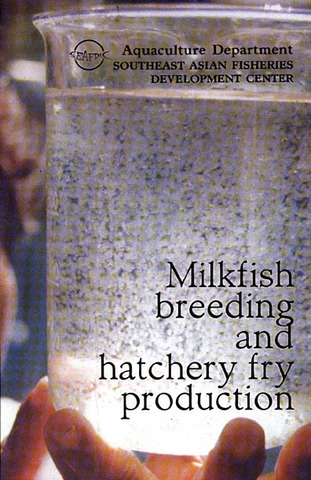Milkfish fry and fingerling industry of the Philippines: methods and practices
- Global styles
- MLA
- Vancouver
- Elsevier - Harvard
- APA
- Help

Date
1983Page views
9,115ASFA keyword
AGROVOC keyword
Taxonomic term
Metadata
Show full item record
Share
Abstract
Milkfish fry catch from Philippine waters can still be increased. Intensified collections in traditional fry grounds and exploitation of new areas may lead to a reduction of adult stock and the possible collapse of the milkfish fry fishery. The implementation of rational conservation and management measures are of immediate concern not only to increase the productivity and number of fry grounds but also to conserve this important aquatic resource.
The present methods of catching milkfish fry involve fry filtration by mobile or stationary devices. The design, construction, area and time of operation of the gears are primarily dictated by the bottom topography of the fry grounds, wind direction, local current patterns and tidal fluctuations.
Catching, handling, storage and transport activities expose the fish to undue stress which contribute to poor survival. The simple method of lowering the salinity of the water medium considerably reduces mortality.
High mortality in nursery ponds has aggravated the seed shortage problem of the milkfish industry. The development of an efficient mass-production technology in rearing milkfish fry to fingerlings and in stunting fingerlings for longer periods could offer the solution not only in meeting the requirements for milkfish seed but also provide part of the fry requirements of other countries in the region.
Description
2nd Edition.
Suggested Citation
Villaluz, A. C., Villaver, W. R., & Salde, R. J. (1983). Milkfish fry and fingerling industry of the Philippines: methods and practices. (Technical Report No. 9) (2nd ed.). Tigbauan, Iloilo, Philippines: Aquaculture Department, Southeast Asian Fisheries Development Center.
Type
Technical ReportISSN
0115-4710Series
Technical report / SEAFDEC Aquaculture Department; No. 9Format
ii, 81 p. : ill.
Collections
- Technical Reports [13]
Related items
Showing items related by title, author, creator and subject.
-
Milkfish fry collection and handling
Villaluz, A.C. (Food and Agriculture Organization of the United Nations, South Pacific Aquaculture Development Project, 1990)Milkfish fry can be collected in almost all the coastal waters of the tropical Indo-Pacific region. The fry season occurs at different times of the year in various sections of the species' geographical range. The season ... -
Milkfish breeding and hatchery technology at SEAFDEC/AQD
Unknown author (Aquaculture Department, Southeast Asian Fisheries Development Center, 1999)Describes the techniques already adopted by the private sector: broodstock management, broodstock diet, commercial fry production, live transport, and larval diet. A list of AQD research publications on milkfish is included. -
Milkfish breeding and hatchery fry production
Unknown author (Aquaculture Department, Southeast Asian Fisheries Development Center, 1999)Summarizes the integrated milkfish broodstock and hatchery operation technology developed by SEAFDEC/AQD.





